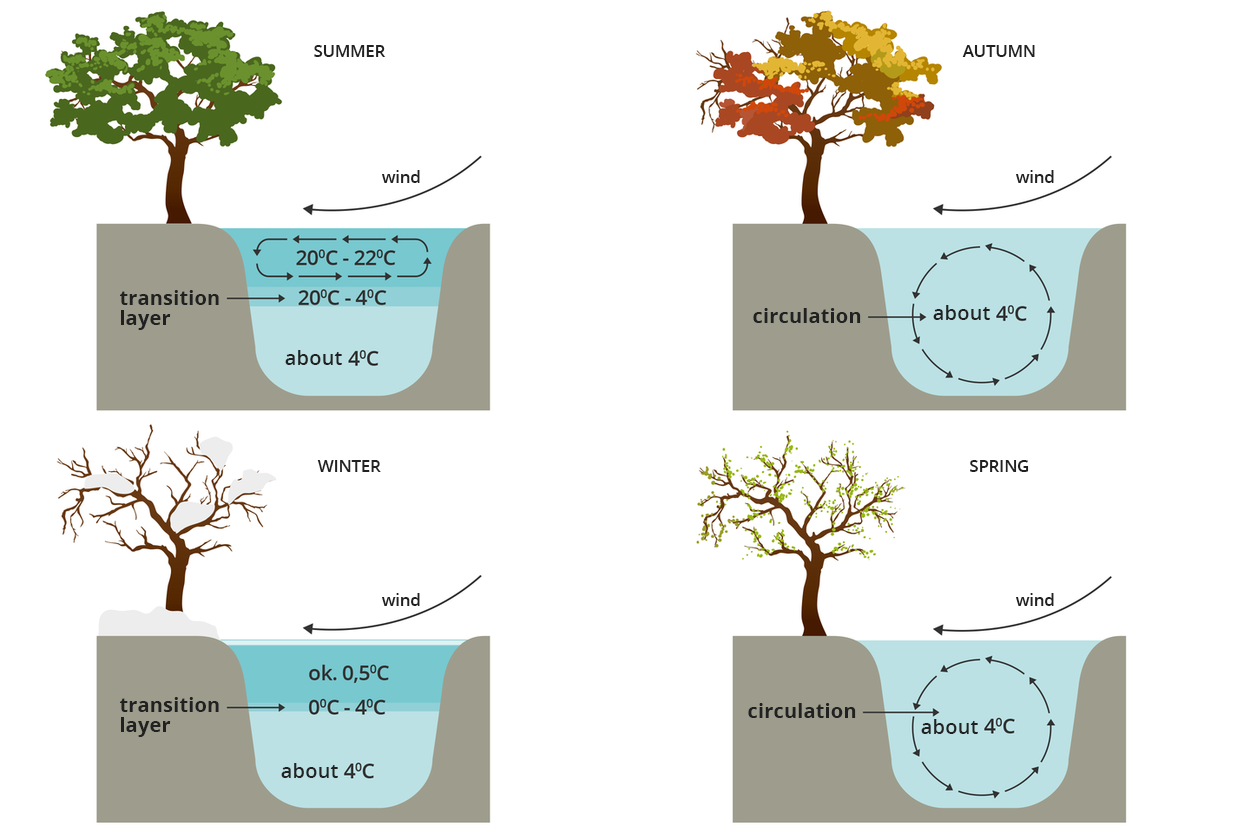Year in a lake
how temperature, pressure and salination affect living conditions in water;
the lake water zones;
that there is a link between living conditions in a lake and organisms that can be found there.
to describe the link between changes in lake water temperature and the formation of water zones;
to describe the link between the density of water and ice and the survivability of organisms in the benthic zone;
to describe living conditions in a lake during different seasons of the year.
Lake water temperature
In the summer, due to the lakelake surface being heated, three water zones are formed. The upper zone is characterised by high and constant temperature. The wind keeps constantly mixing water and air, which facilitates the dissolution of oxygen in water. Therefore, this water zone is the best oxygenated. The intermediate zone is colder and its waters are not mixed. In the bottom layer, where the temperature reaches 4°C, there is also no water movement.
In autumn, the upper and intermediate zones gradually become colder. They reach a temperature nearing 4°C. The division into zones disappears and lake water is mixed.
In winter, water continues to get colder. Zones re‑emerge. Ice floats on the surface. Under the ice, the upper zone with a constant temperature slightly above 0°C is formed. In the intermediate zone, water temperature rises from 0 to 4°C. The bottom zone has the densest water with a constant temperature of 4°C.
In spring, when the Sun starts heating the lake waters, ice melts. At a certain point the water reaches 4°C and waters are once again mixed. Further mixing results in warmer, lighter water rising to the surface and stop mixing with denser, heavier water with a temperature of 4°C that dwell near the lake bed. Water mixing in the spring and autumn delivers oxygen to the benthic zone of the lake.
Before you watch the film titled “Water temperature”, write down a research question and a hypothesis. While watching the film, write down your observations and, at the end, your conclusions.

Film dostępny na portalu epodreczniki.pl
Nagranie filmowe prezentujące eksperyment. Do eksperymentu potrzebujemy wagi, linijki, kostki lodu i wodę. Ważymy i mierzymy kostkę lodu. Następnie wrzucamy kostkę lodu do wody.

Life under the ice
When the frosts come, heat stored during the summer in lake waters allows them to remain in a liquid state. Chilled lake water freezes only after a longer period of frost. A thin layer is formed and as frost continues the ice layer keeps growing thicker. Animals move to the lake bed where water is the warmest at 4°C. Ice floating on the surface of the lake allows them to survive winter. It prevents water from being mixed by the wind, thus protecting deeper layers from becoming colder and freezing.

The lake freezing over also causes problems. The amount of light that reaches the depths is reduced and ice cuts off access to air. Therefore, oxygen cannot dissolve in water. Organisms have to limit their activity. Aquatic plants and phytoplankton in partial darkness reduce carbon dioxide assimilation and oxygen production. Fish reduce predation and some stop eating altogether, burrow in mud and spend entire months motionless. The ones that don’t hibernate occupy the warmest places of the lake and use oxygen delivered near the lake bed as a result of water mixing in autumn. The parts of plants that protrude above the water surface die when the surface is covered in ice. However, their parts that are submerged and buried in mud at the bottom of the lake are able to survive until spring.
Certain amphibians also spend winter at the bottom of lakes. Several weeks spent underwater won’t do them harm. Amphibians breathe through their lungs, but they can also absorb oxygen from water through the skin. In spring, amphibians awake and start absorbing oxygen through their lungs.
Select the temperature in which water has the highest density.
- near 0°C
- near - 4°C
- near 4°C
Summary
Ice floats on the water surface.
Changes in air temperature in subsequent seasons of the year affect lake water temperature.
The ice layer saves lake organisms from freezing during winter.
Keywords
lake, season, water density
Glossary
jezioro – naturalne, pozbawione bezpośredniego kontaktu z morzem, wypełnione wodą zagłębienie terenu